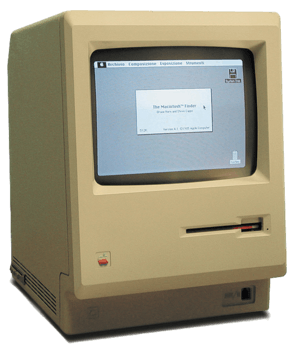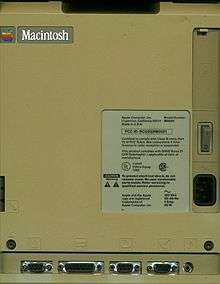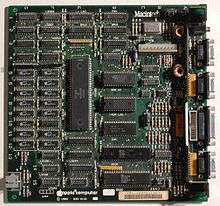Macintosh 128K
 | |
| Also known as | Apple Macintosh |
|---|---|
| Developer | Apple Computer, Inc. |
| Product family | Macintosh |
| Release date | January 24, 1984[1][2] |
| Introductory price | US$2,495 (equivalent to $5,692 in 2015) |
| Discontinued | October 1, 1985[3] |
| Operating system | System Software 1.0[4] |
| CPU | Motorola 68000 @ 7.8336 MHz (6 MHz effectively)[5] |
| Memory | 128 KB RAM (built-in) |
| Predecessor | Apple Lisa, Lisa II |
| Successor | Macintosh 512K |
The Macintosh 128K, originally released as the Apple Macintosh, is the original Apple Macintosh personal computer. Its beige case consisted of a 9 in (23 cm) CRT monitor and came with a keyboard and mouse. A handle built into the top of the case made it easier for the computer to be lifted and carried. It had an initial selling price of $2,495 (equivalent to $5,692 in 2015). The Macintosh was introduced by the now-famous $370,000 (equivalent to $844,174 in 2015) television commercial by Ridley Scott, "1984," that most notably aired on CBS during the third quarter of Super Bowl XVIII on January 22, 1984.[6] Sales of the Macintosh were strong from its initial release on January 24, 1984, and reached 70,000 units on May 3, 1984.[7] Upon the release of its successor, the Macintosh 512K, it was rebranded as the Macintosh 128K.
Features
The Macintosh was designed to achieve adequate graphics performance, which had previously required hardware costing over US $100,000, a price inaccessible to the middle class. This narrow goal resulted in an efficient design which traded off expandability but met or exceeded the baseline performance of its competitors.[8][9]
Processor and memory
The centerpiece of the machine was a Motorola 68000 microprocessor running at 7.8336 MHz, connected to 128 KB RAM shared by the processor and the display controller. The boot procedure and some operating system routines were contained in an additional 64 KB ROM chip. Apple did not offer RAM upgrades. Unlike the Apple II, no source code listings of the Macintosh system ROMs were offered.
The RAM in the Macintosh consisted of sixteen 4164 64kx1 DRAMs.
The 68000 and video controller took turns accessing DRAM every four CPU cycles during display of the frame buffer, while the 68000 had unrestricted access to DRAM during vertical and horizontal blanking intervals. Such an arrangement reduced the overall performance of the CPU as much as 35% for most code as the display logic often blocked the CPU's access to RAM. This made the machine appear to run more slowly than several of its competitors, despite the nominally high clock rate.

Peripherals
The built-in display was a one-bit black-and-white, 9 in (23 cm) CRT with a fixed resolution of 512×342 pixels, establishing the desktop publishing standard of 72 PPI. Expansion and networking were achieved using two non-standard RS-422 DE-9 serial ports named "printer" and "modem"; they did not support hardware handshaking. An external floppy disk drive could be added using a proprietary connector (19-pin D-sub). The keyboard and mouse used simple proprietary protocols, allowing some third-party upgrades. The original keyboard had no arrow keys, numeric keypad or function keys. This was an intentional decision by Apple, as these keys were common on older platforms and it was thought that the addition of these keys would encourage software developers to simply port their existing applications to the Mac, rather than design new ones around the GUI paradigm.[10] Later, Apple would make a numeric keypad available for the Macintosh 128K. The keyboard sold with the newer Macintosh Plus model would include the numeric keypad and arrow keys, but still no function keys. As with the Apple Lisa before it, the mouse had only a single button. Standard headphones could also be connected to a monaural jack. Apple also offered their 300 and 1200 bit/s modems originally released for the Apple II line. Initially, the only printer available was the Apple ImageWriter, a dot matrix printer which was designed to produce 144 dpi WYSIWYG output from the Mac's 72 dpi screen. Eventually, the LaserWriter and other printers were capable of being connected using AppleTalk, Apple's built-in networking system.
Storage
The Macintosh contained a single 400 KB, single-sided 3.5-inch floppy disk drive, dedicating no space to other internal mechanical storage. The Mac OS was disk-based from the beginning, as RAM had to be conserved, but this "Startup Disk" could still be temporarily ejected. (Ejecting the root filesystem remained an unusual feature of the classic Mac OS until System 7.) One floppy disk was sufficient to store the System Software, an application and the data files created with the application. Indeed, the 400 KB drive capacity was larger than the PC XT's 360 KB 5.25-inch drive. However, more sophisticated work environments of the time required separate disks for documents and the system installation. Due to the memory constraints (128 KB) of the original Macintosh, and the fact that the floppies could hold 400 KB, users frequently had to swap disks in and out of the floppy drive. For this reason, external floppy drives were frequently used. The Macintosh External Disk Drive (mechanically identical to the internal one, piggybacking on the same controller) was a popular add-on at US $495. Third-party hard drives were considerably more expensive and connected to the slower serial port (as specified by Apple), though a few manufacturers chose to use the faster non-standard floppy port. The 128K can only use the original Macintosh File System for storage.

Cooling
The unit did not include a fan, relying instead on convection cooling, which made it quiet while in operation. Steve Jobs insisted that the Macintosh ship without a fan, which persisted until the introduction of the Macintosh SE in 1987. This was allegedly a source of many common, costly component failures in the first four Macintosh models. This was enough of a problem to prompt the introduction of a third-party, external cooling fan. This fan unit fitted inside the Macintosh's carrying-handle slot and produced a forced draft through the computer's existing ventilation holes.[11]
Software
The Macintosh shipped with the very first System and Finder application, known to the public as "System 1.0" (formally known as System 0.97 and Finder 1.0). The original Macintosh saw three upgrades to both before it was discontinued. Apple recommends System 2.0 and Finder 4.2, with System 3.2 and Finder 5.3 as the maximum. System 4.0 officially dropped support for the Macintosh 128K because it was distributed on 800 KB floppy disks, which could not be used by the 128K.
The applications MacPaint and MacWrite were bundled with the Mac. Other programs available included MacProject, MacTerminal and Microsoft Word. Programming languages available at the time included MacBASIC, MacPascal[12] and the Macintosh 68000 Development System.[13] The Macintosh also came with a manual and a unique guided tour cassette tape which worked together with the guided tour diskette as a tutorial for both the Macintosh itself and the bundled applications, since most new Macintosh users had never used a mouse before, much less manipulated a graphical user interface.
Models
The computer was released in January 1984 as simply the Apple Macintosh. Following the release of the Macintosh 512K in September, which expanded the memory from 128 KB to 512 KB, the original Macintosh was re-branded Macintosh 128K and nicknamed the "thin Mac." The new 512K model was nicknamed the "fat Mac." While functionally the same, as closed systems, the Macintosh and Macintosh 128K were technically two different computers, with the re-badged 128K containing a completely redesigned logic board to easily accommodate both 128 KB and 512 KB RAM configurations during manufacturing. Though the RAM was still permanently soldered to the logic board, the new design allowed for easier (though unsanctioned) third-party upgrades to 512 KB. In addition, most of the newer models contained the 1984 revision B of the ROM to accommodate changes in the 400 KB floppy disk drive.[14]
The increased RAM of the 512K was vitally important for the Macintosh as it finally allowed for more powerful software applications, such as the then-popular program Microsoft Multiplan. However, Apple continued to market the 128K for over a year as an entry-level computer, the mid-level 512K and high-end Lisa (and claiming that it could be easily expanded should the user ever need more RAM).
Expansion
Jobs stated that because "customization really is mostly software now ... most of the options in other computers are in Mac", unlike the Apple II the Macintosh 128K did not need slots, which he described as costly and requiring larger size and more power.[15] It was not upgradable by the user and only Apple service centers were permitted to open the case.[16] All accessories were external, such as the MacCharlie that added IBM PC compatibility.[17] There was no provision for adding internal storage, more RAM or any upgrade cards, however some of the Macintosh engineers objected to Jobs's ideas and secretly developed workarounds for them. As an example, the Macintosh was supposed to have only 17 address lines on the motherboard, enough to support 128k of system RAM, but the design team added an additional two address lines without Jobs's knowledge, making it possible to expand the computer to 512k, although the actual act of upgrading system RAM was difficult and required piggybacking additional RAM chips overtop the onboard 4164 chips. In September 1984, after months of complaints over the Mac's inadequate RAM, Apple released an official 512k machine. Although this had always been planned from the beginning, Steve Jobs maintained if the user desired more RAM than the Mac 128 provided, he should simply pay extra money for a Mac 512 rather than upgrade the computer himself. When the Mac 512 was released, Apple rebranded the original model as "Macintosh 128k" and modified the motherboard to allow easier RAM upgrades. Improving on the hard-wired RAM thus required a motherboard replacement (which was priced similarly to a new computer), or a third-party chip replacement upgrade, which was not only expensive but would void Apple's warranty. The difficulty of fitting software into its limited free memory, coupled with the new interface and event driven programming model, discouraged software vendors from supporting it, leaving the 128K with a relatively small software library. Whereas the Macintosh Plus, and to a lesser extent the Macintosh 512K, are compatible with much later software, the 128K is limited to specially crafted programs. A stock Mac 128K with the original 64K ROM is neither compatible with Apple's external 800 KB drive with HFS nor with Apple's Hard Disk 20. A Mac 128K that has been upgraded with the newer 128K ROM (called a Macintosh 128Ke) can use internal and external 800 KB drives with HFS, as well as the HD20. Both can print on an AppleShare network, but neither can do file sharing because of their limited RAM.
OEM upgrades
Apple did provide an expensive "official" upgrade path for the Macintosh 128K, which included a motherboard replacement effectively making it a Macintosh 512K, for the price of US $995.[18][19] Additionally, Apple offered an 800 KB floppy disk drive kit, including updated 128K ROMs. Finally, a Mac 128K could be upgraded to a Macintosh Plus by swapping the logic board as well as the case back (to accommodate the slightly different port configuration) and optionally adding the Macintosh Plus extended keyboard. Any of the kits could be purchased alone or together at any time, for a partial or full upgrade for the Macintosh 128K. All upgrades were required to be performed by professional Apple technicians,[20] who reportedly refused to work on any Macintosh upgraded to 512K without Apple's official upgrade, which at US$700 was much more expensive than about $300 for third-party versions.[21]
Credits

The original Macintosh was unusual in that it included the signatures of the Macintosh Division as of early 1982 molded on the inside of the case. The names were Peggy Alexio, Colette Askeland, Bill Atkinson, Steve Balog, Bob Belleville, Mike Boich, Bill Bull, Matt Carter, Berry Cash, Debi Coleman, George Crow, Donn Denman, Christopher Espinosa, Bill Fernandez, Martin Haeberli, Andy Hertzfeld, Joanna Hoffman, Rod Holt, Bruce Horn, Hap Horn, Brian Howard, Steve Jobs, Larry Kenyon, Patti King, Daniel Kottke, Angeline Lo, Ivan Mach, Jerrold Manock, Mary Ellen McCammon, Vicki Milledge, Mike Murray, Ron Nicholson Jr., Terry Oyama, Benjamin Pang, Jef Raskin, Ed Riddle, Brian Robertson, Dave Roots, Patricia Sharp, Burrell Smith, Bryan Stearns, Lynn Takahashi, Guy "Bud" Tribble, Randy Wigginton, Linda Wilkin, Steve Wozniak, Pamela Wyman and Laszlo Zidek.
The Mac 128/512 also included an Easter Egg in the OS ROM. If the user went to the system debugger and typed G 4188A4, a graphic reading "Stolen from Apple Computers" would appear in the upper left corner of the screen. This was designed to prevent unauthorized cloning of the Macintosh after numerous Apple II clones appeared, many of which simply stole Apple's copyrighted system ROMs. Steve Jobs allegedly planned that if a Macintosh clone appeared on the market and a court case happened, he could access this Easter Egg on the computer to prove that it was using pirated Macintosh ROMs.
Reception
BYTE in 1984 found the hardware and software design (which it predicted would be "imitated but not copied") impressive, but criticized the lack of a standard second disk drive. The magazine predicted that the computer would popularize the 3.5" floppy disk drive standard, that the Macintosh would improve Apple's reputation, and that it "will delay IBM's domination of the personal computer market." BYTE concluded that the Macintosh was "the most important development in computers in the last five years. [It] brings us one step closer to the ideal of computer as appliance."[16] Jerry Pournelle wrote in the magazine "I don't recommend that you get one" as of May 1984, citing various issues. He noted, however, that the Macintosh attracted people "who previously hated computers ... There is, apparently, something about mice and pull-down menus and icons that appeal to people previously intimidated by A> and the like".[22]
Timeline of compact Macintosh models

See also
References
- ↑ Linzmayer, Owen W. (2004). Apple Confidential 2.0. No Starch Press. p. 113. ISBN 1-59327-010-0.
- ↑ "The Macintosh Product Introduction Plan". Stanford University Libraries & Academic Information Resources. Archived from the original on July 21, 2010.
- ↑ "Macintosh 128K: Technical Specifications". apple.com. Retrieved March 27, 2015.
- ↑ "Official Apple Support". apple.com.
- ↑ "Byte Magazine Volume 09 Number 02 - Benchmarks". Internet Archive.
- ↑ Burnham, David (March 4, 1984). "The computer, the consumer and privacy". The New York Times. Washington, D.C. Retrieved March 27, 2015.
- ↑ Polsson, Ken (July 29, 2009). "Chronology of Apple Computer Personal Computers". Archived from the original on July 10, 2009. Retrieved August 27, 2009.
- ↑ Polsson, Ken. "Chronology of IBM Personal Computers". Islandnet.com. Archived from the original on October 15, 2006. Retrieved March 19, 2015.
- ↑ "Mac GUI". macgui.com.
- ↑ "History of computer design: Apple Macintosh". landsnail.com.
- ↑ "The Fanny Mac System Saver fan for 1984 Macintosh 128k 512k Plus M0001 Rare!". Worthpoint.com. Retrieved February 1, 2014.
- ↑ "Mac GUI". macgui.com.
- ↑ "Mac GUI". macgui.com.
- ↑ "400K Drive Problem/Cure: Fails to Read/Write or MacTest". apple.com.
- ↑ "An Interview: The Macintosh Design Team". BYTE. Interview with Lemmons, Phil. February 1984. pp. 58–80. Retrieved 7 July 2016.
- 1 2 Williams, Gregg (February 1984). "The Apple Macintosh Computer". BYTE. p. 30. Retrieved October 22, 2013.
- ↑ Sandberg-Diment, Erik (September 24, 1985). "Linking Mac to the IBM PC". The New York Times (review). Retrieved October 27, 2013.
- ↑ "Mac GUI". macgui.com.
- ↑ "Mac GUI". macgui.com.
- ↑ Macintosh Plus: Description (Discontinued) The Macintosh Plus Logic Board Kit
- ↑ Webster, Bruce (September 1985). "West Coast Faire, Mac Stuff, and the Amiga". BYTE. p. 401. Retrieved 20 March 2016.
- ↑ Pournelle, Jerry (Aug 1984). "Between Conventions". BYTE. p. 313. Retrieved 24 February 2016.
External links
| Wikimedia Commons has media related to Macintosh. |
- Full Macintosh 128K specifications, Apple Computer
- Macintosh 128K profile, Low End Mac.
- Mac 128K Information page at Mac512.com
- Original Review of the Macintosh by Lawrence J. Magid (January 29, 1984) at the Wayback Machine (archived September 20, 2008)
- Online attempt at simulating Macintosh System 1
- Mac Essentials, Lost 1984 Videos
- "The Vintage Mac Museum: Mac 128K Slideshows". Archived from the original on January 6, 2016. Retrieved 2016-01-06.
- Apple Macintosh before System 7 Macintosh 128K Hardware
- Tips For the 128K Support For 128K Diehard Users
- The M0001 Registry Owners of Vintage Macintosh
- Inside the Macintosh 128K
- The Original Macintosh, anecdotes and the people who made it